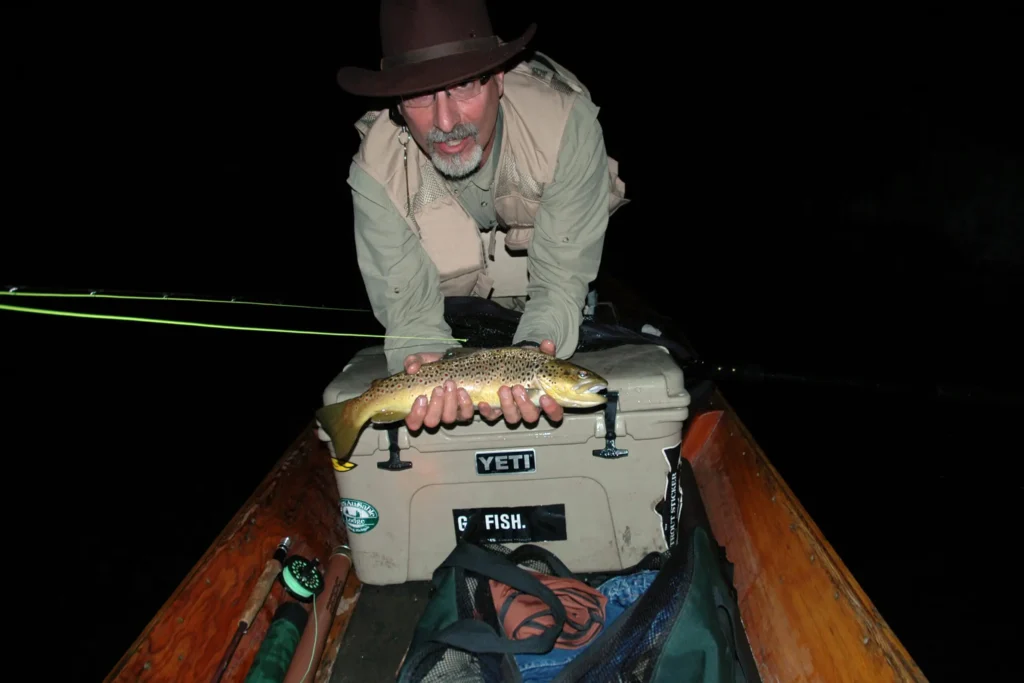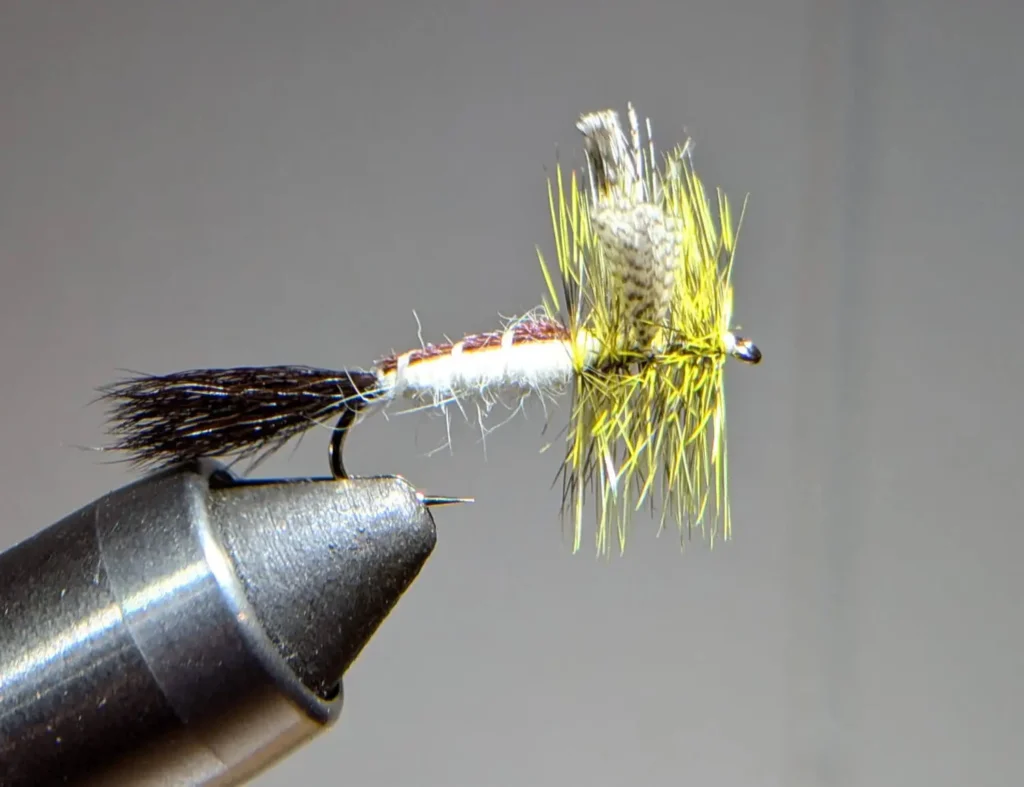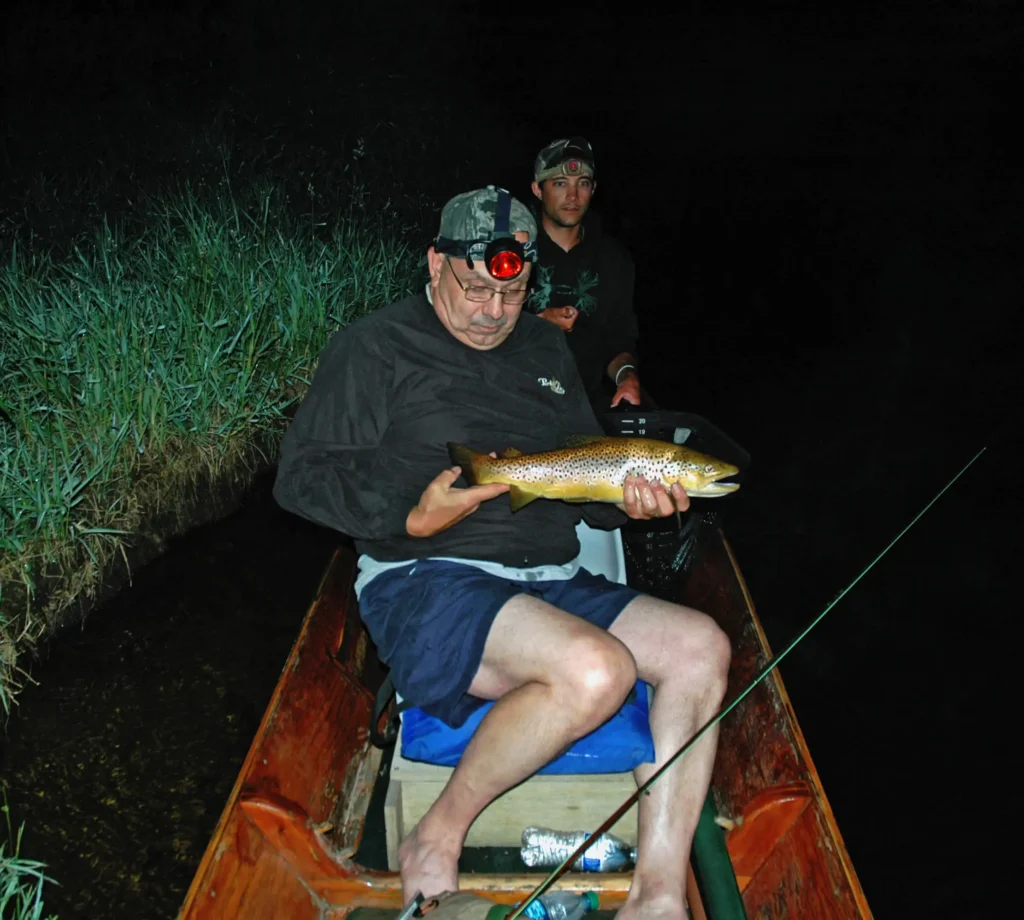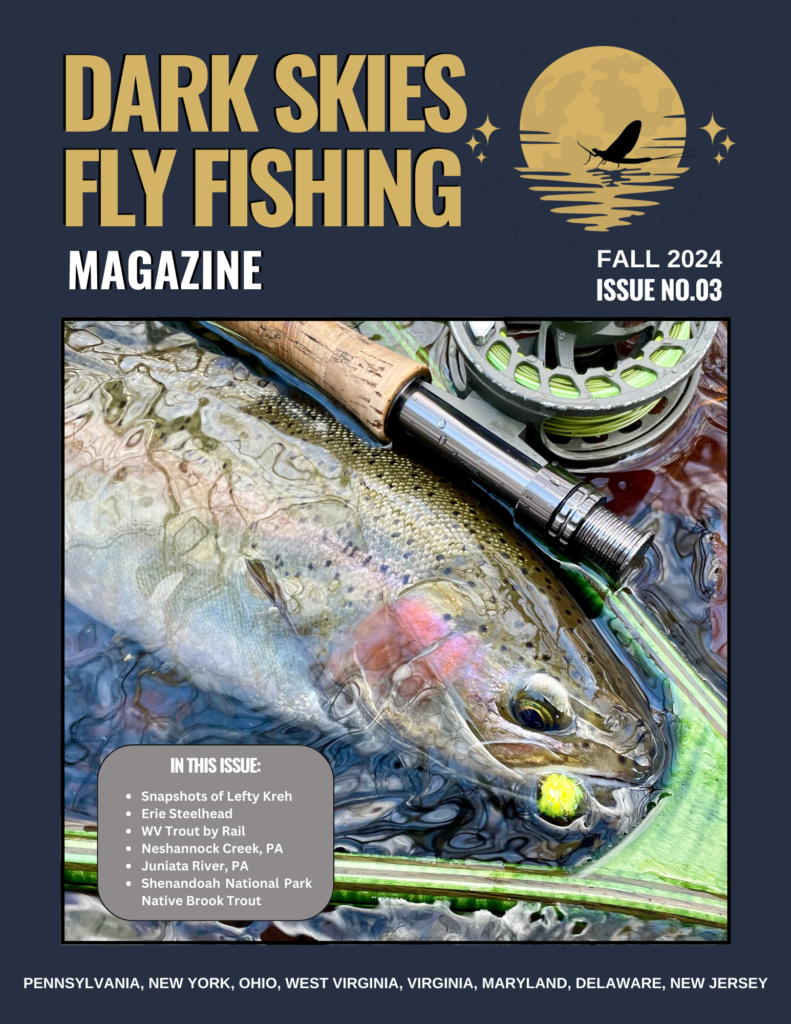Michigan’s Au Sable Brown Trout After Dark…On Dry Flies!

This could get confusing if I don’t first explain that the Au Sable River in upstate Michigan is 700 miles from the Ausable River in New York State. Notice that the river in Michigan is correctly spelled with a space left between the u and capitalized “S”, whereas the similarly named river in the Empire State is correctly spelled in continuum and with a small “s.” It occurs to me that this is a great argument against anyone who insist there is no purpose to capitalize letters.
The Au Sable River, near Grayling, Michigan, is a wonderful trout fishery, and I learned firsthand that big browns like to make appearances in this waterway after dark.
As is often the case among fly fishers, I became aware of the fantastic night fishing for brown trout in the Au Sable thanks to a friend, who told me of his experiences there. I leaped at the opportunity to join him when he asked me to tag along during one of his adventures. My buddy Joe and I have been friends for 40 years and I can’t imagine my life without his friendship.
During the 10-hour drive west and then north, I picked Joe’s brain and gather Au Sable brown trout tips. Sure, I’d caught stocked browns and even a share of natives in Pennsylvania, but this was different. We were going to participate in a float trip, which I’d never done before, and we would be fishing a strange (to me) waterway in the dark, something else I’d never done. My anticipation was piqued when Joe assured me we would likely catch a few rainbows and small browns in the evening before darkness fell, but he assured me the big ones come out at night!
Early Evening Catches

We met our talented young aide at about 5:45 PM. Even before our introductions, it was immediately apparent that this trip would introduce me to several “firsts.” Mr. Bartha was waiting near a watercraft unlike any other I had ever seen. It was a unique vessel that is rarely seen elsewhere but is popular near the Au Sable and Grayling areas.
The vessel is known as a Longboat, and it is basically an extremely long, flat-bottom canoe with ample room for three people. When you see one of these vessels, you know instantly it is a boat meant for fishing, rather than a romantic float with a loved one. Our guide explained that the flat-bottom longboats are a perfect design for use on the Au Sable because their low draft allows them to float in areas that are sometimes just a couple of feet deep; plus they provide a stable platform from which to cast.
My friend Joe and I are comfortable with the feel of our fly rods, so we politely rejected our guide’s offer to supply rods and reels. Mr. Bartha suggested the flies we should use, and of course, we were wise enough to accept his recommendations. I believe that one of the worst things a visiting fisherman can do is assume to know more than a local expert.
An olive Wooly Bugger was the first fly recommended to me because, our guide explained, the river held a good population of olive to blackish stoneflies. My friend Joe is a dry fly enthusiast, which explains why a size 16 Adams was his first choice. As predicted, my friend enjoyed success before I did. An average rainbow trout slurped his fly from the surface shortly after our float began. A 12-13-inch brownie inhaled my bugger a short time later. At some point before dark, I switched to a tan caddis fly and Joe tied a March Brown to his tippet. We caught and released two or three average rainbows before dark.
Dry Flies After Dark

The sun was setting when Joe explained to our guide that I should cast to the first trout we would encounter after dark. His generosity, though appreciated, left me a little nervous. “Perhaps it would be better to see the technique performed by my experienced friend,” was my first thought.
Young Mr. Bartha handed a “Michigan Caddis fly” to my companion, who in turn handed it to me. Joe illuminated the darkness with his red-capped headlamp, enabling me to see well enough to tie the large dry fly to my tippet. It was the largest dry fly I have ever offered a trout.
The term “Michigan Caddis Fly is more commonly known in the eastern United States as a Green Drake, and the intent of this fly on the Au Sable is to imitate a Hex mayfly. To best explain the use of such a large fly on the Au Sable, let me explain that according to the “Orvis Encyclopedia of Fly Fishing,” the Hexagenia limbata (Hex), is the largest mayfly in North America.
Our guide continued to maneuver our vessel expertly through the darkness, leaving no doubt that he knew the river’s pathway like the back of his hand. “Please, do not use any unnecessary lights,” he suggested.
We were surrounded by pitch black, and I couldn’t help but wonder what he considered necessary. In my mind, a full moon might have removed need for artificial light, but less than a quarter of the moon lit the sky during our visit.
Some sections of the route were tricky enough to maneuver that he and my friend Joe used their red-capped headlamps to see, but they were not used excessively. Our guide understood my need as an outdoor communicator to capture images of the event. He agreed to let me use my camera’s flash when photography opportunities became available.
“Jerry, I’ll get us near the stream bank when we catch one,” he suggested. “It will be best if you direct your flash down and near the riverbank to avoid lighting the open water, which could spook a wary brown.”
We held our lines and floated through the darkness for nearly an hour. I was starting to have doubts, but then we heard the unmistakable sound of a large fish splashing the surface as it gulped down a hapless insect. Joe and our guide encouraged me to cast toward the sound.
My fun brain said do it, but my cautious brain entertained quick, crazy doubts. Let me get this straight, I thought. We’re on a narrow stretch of the river, and they want me to make a blind cast to strange water I’ve never seen? What if I snag something behind me that I can’t see during the back cast? These questions raced through my mind in an instant before I did as suggested and go my fly in the water.
I managed to avoid snagging bankside vegetation, but I couldn’t be sure my fly landed in the correct spot. It felt good, though, and I was reasonably sure my fly landed in the vicinity of the sound we’d hear. We heard another large splash and for the briefest moment, I assumed the trout had risen to devour another Hex mayfly. A sudden tug and shake transferred through my Orvis fly rod to my hands, leaving no doubt that the sound we heard was made by a hefty brown trout that accepted my imitation. I lifted the rod, which instantly bent as the battle commenced.
As I played the fish, I remembered doubting that I could accurately cast to only a sound. The words to explain the exuberance of that moment fail me. It was satisfying to discover I possessed the skill to “feel” a cast and know it was good without seeing it. Perhaps you can Imagine being guided to an unfamiliar trout stream by a trusted friend, who then blindfolds you before throwing a stone into the water, and then encourages you to cast to the splash you only heard. You would probably be surprised by how well you could do it!
After so many things had gone right, I didn’t want to lose the fish. The feisty trout had some weight. Applying too much or too little torque could have left me heartbroken. Eventually, the robust fish was near the boat, and I felt relief after our competent guide had it securely in the net.
After adjusting the settings of my Nikon DSLR camera, I asked my friend if he would quickly take a couple of grip-and-grin shots of me and the trout. Then I carefully lifted the fish from the net, and Joe pressed the shutter button a couple of times before the beautiful brown trout was gently released to fight another night.
Another Big Brown

We only floated about five more minutes before again hearing the telltale sound of a trout slurping a bug of the surface. It was Joe’s turn to cast. His offering was perfect. Joe lifted and his fly rod bent.
The look on my friend’s face was serious and betrayed his determination to keep that trout on the hook, and after a well-executed battle, our guide reached out with his net and again captured an eloquent fish. It was my pleasure to photograph a large, stunning brown trout in the hands of a proud fisherman.
The sounds of tree frogs, bullfrogs, and crickets echoed through the crisp, evening air as we continued our float. We occasionally passed by cabins and cottages whose dim, glowing lights pierced the darkness. I recall feeling envious of the few streamside fishermen we encountered, who I assumed resided in those dwellings. They might have remained hidden if not for their similar headlamps, which were also equipped with red-capped lenses. I can only imagine how many brown trout they catch under the dark, Michigan skies each year.
Oh, to own a cottage along the banks of the Au Sable!
Did You Enjoy This Article?
Stay up to date with the Dark Skies Fly Fishing monthly newsletter for free and receive the latest posts in fly fishing news, tricks, tips, and techniques, stream reports, as well as updates on new flies added to the Online Store and exclusive discounts!
Sign Up Now

